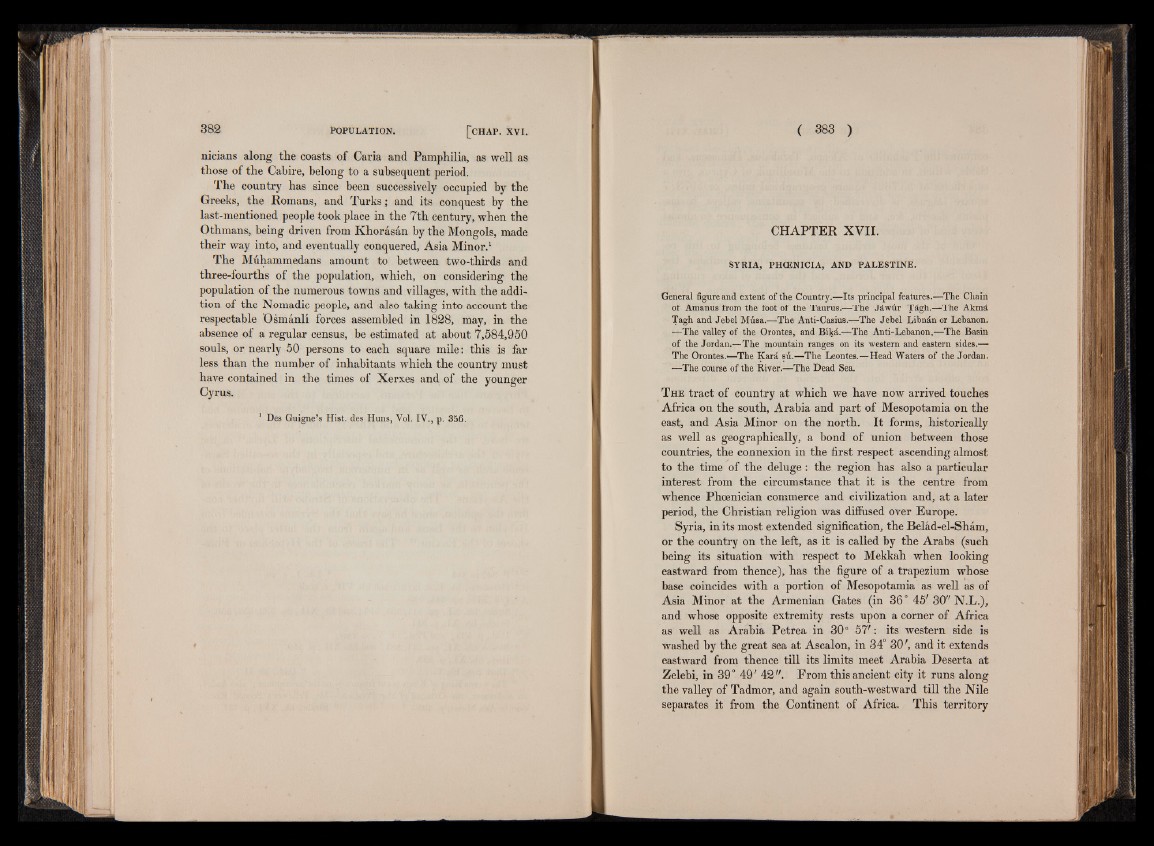
nicians along the coasts of Caria and Pamphilia, as well as
those of the Cabire, belong to a subsequent period.
The country has since been successively occupied by the
Greeks, the Romans, and Turks ; and its conquest by the
last-mentioned people took place in the 7th century, when the
Othmans, being driven from Khoràsàn by the Mongols, made
their way into, and eventually conquered, Asia Minor.1
The Muhammedans amount to between two-thirds and
three-fourths of the population, which, on considering the
population of the numerous towns and villages, with the addition
of the Nomadic people, and also taking into account the
respectable Osmànli forces assembled in 1828, may, in the
absence of a regular census, be estimated at about 7,584,950
souls, or nearly 50 persons to each square mile: this is far
less than the number of inhabitants which the country must
have contained in the times of Xerxes and of the younger
Cyrus.
1 Des Guigne’s Hist, des Huns, Vol. IV., p. 356.
CHAPTER XVII.
SYRIA, PHCENICIA, AND PALESTINE.
General figure and extent of the Country.—Its principal features.—The Chain
of Amanus from the foot of the Taurus.—The Jdwur Tdgh.—The Akmd
Tagh and Jebel Miisa.—The Anti-Casius.—The Jebel Libndn or Lebanon.
—The valley of the Orontes, and Bikd.—The Anti-Lebanon.—The Basin
of the Jordan.—The mountain ranges on its western and eastern sides.—;
The Orontes.—The Kara sii.—The Leontes.—Head Waters of the Jordan.
—The course of the River.—The Dead Sea.
T h e tract of country at which we have now arrived touches
Africa on the south, Arabia and part of Mesopotamia on the
east, and Asia Minor on the north. It forms, historically
as well as geographically, a bond of union between those
countries, the connexion in the first respect ascending almost
to the time of the deluge: the region has also a particular
interest from the circumstance that it is the centre from
whence Phoenician commerce and civilization and, at a later
period, the Christian religion was diffused over Europe.
Syria, in its most extended signification, the Belad-el-Sham,
or the country on the left, as it is called by the Arabs (such
being its situation with respect to Mekkah when looking
eastward from thence), has the figure of a trapezium whose
base coincides with a portion of Mesopotamia as well as of
Asia Minor at the Armenian Gates (in 36° 45' 30" N.L.),
and whose opposite extremity rests upon a corner of Africa
as well as Arabia Petrea in 30° 57': its western side is
washed by the great sea at Ascalon, in 34° 30', and it extends
eastward from thence till its limits meet Arabia Deserta at
Zelebi, in 39° 49' 42". From this ancient city it runs along
the valley of Tadmor, and again south-westward till the Nile
separates it from the Continent of Africa. This territory